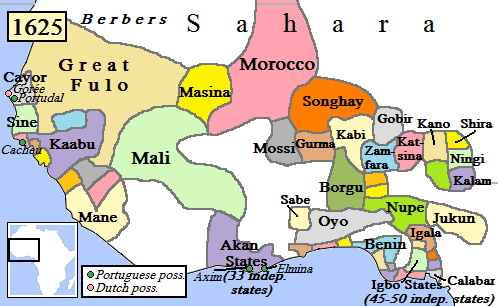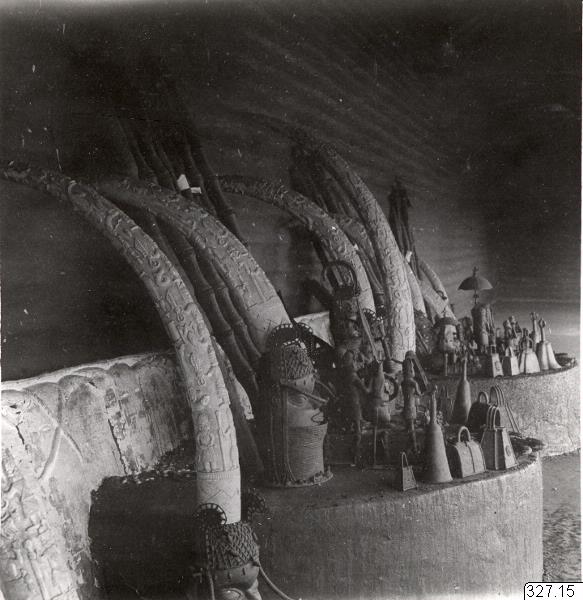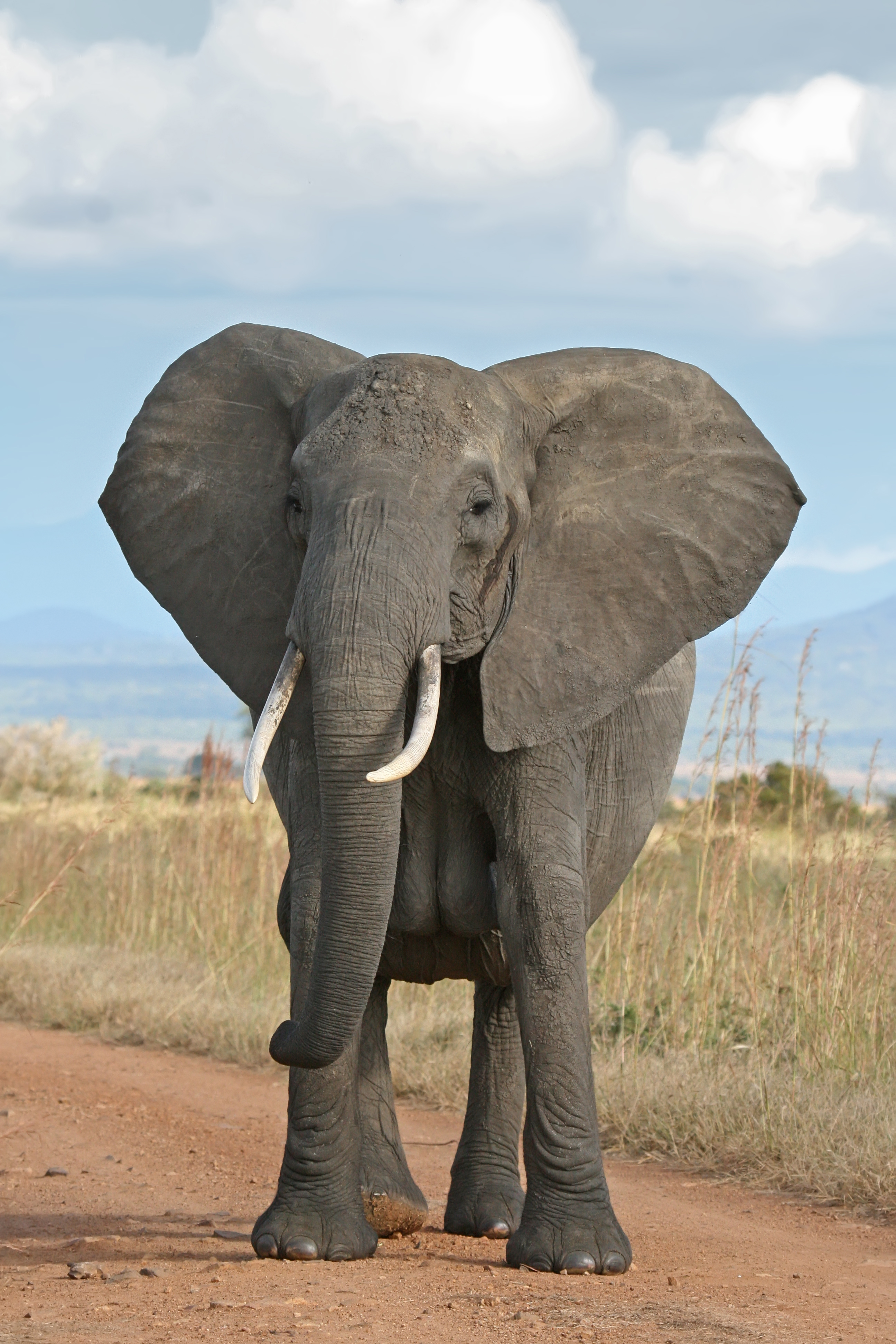|
Oba's Crown
An Oba's crown represents the highest level of authority vested in Yoruba rulers. Referred to as an Ade, the bead-embroidered crown is the foremost attribute of the ruler. An oba's crown may also be referred to as an Adenla, or great crown. Andenla are elaborate conical headdresses, like the ade, but feature a heavily beaded veil that covers the face. In his article on the topic, Robert F. Thompson writes, "The crown incarnates the intuition of royal ancestral force, the revelation of great moral insight in the person of the king, and the glitter of aesthetic experience." Usage After being consecrated as leader, a Yoruba oba must not reveal his face to the public. Instead, he wears an ade or adenla. Oba crowns typically feature at least one stylized face depicted in applied beadwork and designed to identify the king when appearing in public. Some examples of crowns have more than one face. Although their significance is unknown, depictions are frequently associated with Odùduw ... [...More Info...] [...Related Items...] OR: [Wikipedia] [Google] [Baidu] |
Brooklyn Museum 70
Brooklyn () is a Boroughs of New York City, borough of New York City, coextensive with Kings County, in the U.S. state of New York (state), New York. Kings County is the most populous Administrative divisions of New York (state)#County, county in the State of New York, and the County statistics of the United States#Most densely populated, second-most densely populated county in the United States, behind New York County (Manhattan). Brooklyn is also New York City's most populous borough,2010 Gazetteer for New York State United States Census Bureau. Retrieved September 18, 2016. with 2,736,074 residents in 2020. Named after the Dutch village of Breukelen, Brooklyn is located on the western portion of Long Island and shares a border with the borough of Queens. ... [...More Info...] [...Related Items...] OR: [Wikipedia] [Google] [Baidu] |
Oyo Empire
The Oyo Empire was a powerful Yoruba empire of West Africa made up of parts of present-day eastern Benin and western Nigeria (including Southwest zone and the western half of Northcentral zone). It grew to become the largest Yoruba language, Yoruba-speaking state and rose through the outstanding organizational and administrative skills of the Yoruba people, wealth gained from trade, and a powerful cavalry. The Oyo State, Oyo Empire was one of the most politically important states in the entirety of Western Africa from the mid-17th to the late 18th century, and held sway not only over most of the other kingdoms in Yorubaland, but also over nearby African states, notably the Fon people, Fon Kingdom of Dahomey in the modern Republic of Benin on its west. History Legend of origin The origins of the Oyo Empire lie with Oranyan (also known as Oranmiyan), the last prince of the Yoruba Kingdom of Ile-Ife (Ife). Oranmiyan made an agreement with his brother to launch a punitive raid o ... [...More Info...] [...Related Items...] OR: [Wikipedia] [Google] [Baidu] |
Benin Ancestral Altars
Benin ancestral altars are adorned with some of the finest examples of art from the Benin Kingdom of south-central Nigeria. The role of ancestral altars in Benin culture According to anthropologists Kulcher and Melion, art objects or visual images do not merely encode memory but actively engender modes of recollection. A Benin ancestral altar is such a locus for constructing memory. Its purpose was to establish in the most lasting way possible that the deceased had successfully fulfilled his social destiny or ''akhonmioto''. Therefore, the role of the objects on ancestral altars was to construct memory and affirm social identity. Additionally, altars serve as a site through which a living leader communicated with his ancestor via the latter's commemorative head. Ancestral altars ensure dynastic continuity and facilitate the consistent continuity of ideals of leadership. Paternal ancestral altars, ''aru erha'', consist of a raised mud platform set against a wall. A series of el ... [...More Info...] [...Related Items...] OR: [Wikipedia] [Google] [Baidu] |
Shango
Shango (Yoruba language: Ṣàngó, also known as Changó or Xangô in Latin America; and as Jakuta or Badé) is an Orisha, a deity in Yoruba religion. Genealogically speaking, Shango is a royal ancestor of the Yoruba as he was the third Alaafin of the Oyo Kingdom prior to his posthumous deification. Shango has numerous manifestations, including Airá, Agodo, Afonja, Lubé, and Obomin. He is known for his powerful double axe (Oṣè). He is considered to be one of the most powerful rulers that Yorubaland has ever produced. In the New World, he is syncretized with either Saint Barbara or Saint Jerome. Historical figure Ṣàngó was the third Alafin of Oyo, following Oranmiyan and Ajaka. He brought prosperity to the Oyo Empire. According to Professor Mason's ''Mythological Account of Heroes and Kings'', unlike his peaceful brother Ajaka, he was a powerful and violent ruler. He reigned for seven years which were marked by his continuous campaigns and many battles. His reign end ... [...More Info...] [...Related Items...] OR: [Wikipedia] [Google] [Baidu] |
Iperu, Remo
Iperu or Iperu Akesan Bale Oja is a town near the Ibu River in Ogun State in the southwestern region of Nigeria. It is the most populous town in the Remo Region of the Ikenne Local Government Area. The entire LGA has an area of 137.13 km² and a population of 178,412 at the 2006 census. Etymology There are many assertions about the name of the town Iperu: The first school of thought i.e. oral African History says Akesan was said to have settled at the present Akesan market where she sold cooked maize. It was said that there was a palm tree that had sunk close-by where she sat to sell her wares, and there was a hole where the palm tree sank, meaning in Yoruba " ''Ibi tí ọ̀pẹ̀ ti rù''", the sentence was abridged to "Iperu". The second school of thought i.e. oral African History about the name "Iperu" was that a lot of palm-trees abound around the place where Akesan was selling her cooked maize. The place where there were a lot of palm trees or the place where palm tr ... [...More Info...] [...Related Items...] OR: [Wikipedia] [Google] [Baidu] |
Abeokuta
Abeokuta is the capital city of Ogun State in southwest Nigeria. It is situated on the east bank of the Ogun River, near a group of rocky outcrops in a wooded savanna; north of Lagos by railway, or by water. , Abeokuta and the surrounding area had a population of 449,088. Geography and economy Abẹokuta lies in fertile country of wooded savanna, the surface of which is broken by masses of grey granite. It spreads over an extensive area, being surrounded by mud walls 18 miles in extent. Palm oil, lumber, natural rubber, yams, rice, cassava, maize, cotton, other fruits, and shea butter are the chief articles of trade. It is a key export location for cocoa, palm products, fruit, and kola nuts. Both rice and cotton were introduced by the missionaries in the 1850s and have become integral parts of the economy, along with the dye indigo. Abeokuta lies below the Olumo Rock, home to several caves and shrines. The town depends on the Oyan River Dam for its water supply, which ... [...More Info...] [...Related Items...] OR: [Wikipedia] [Google] [Baidu] |
Ilesha
Ilesa () is an ancient town located in the Osun State, southwest Nigeria; it is also the name of a historic kingdom (also known as Ijesha) centred on that village. The state is ruled by a monarch bearing the title of the Owa Obokun Adimula of Ijesaland. The state of Ilesa consisted of Ilesa itself and a number of smaller surrounding cities. The Ijesa, a term also denoting the people of the state of Ilesa, are part of the present Osun State of Nigeria. Some of the popular towns of the Ijesa are Odo-Ijesa, Ilaje, Igbogi, Ise-Ijesa, Ibokun, Erin Ijesa, Ijeda-Ijesa, Ipetu Jesa, Ijebu-Jesa, Esa-Oke,Esa Odo, Ipole Ijesa, Ifewara Ijesa, Ipo Arakeji, Iloko Ijesa, Iwara Ijesa, Iperindo Ijesa, Erinmo Ijesa, Iwaraja Ijesa, Oke-Ana Ijesa, Idominasi, Ilase Ijesa, Igangan ijesa, Imo Ijesa, Alakowe Ijesa, Osu Ijesa, Eti Oni, Itaore, Itagunmodi, Iyinta, Itaapa, Epe Ijesa, Omo Ijesa, Eti-oni, Ibokun, Inila, Ijinla, Iloba Ijesa, Odo Ijesa, Imogbara Ijesa, Eseun Ijesa, Iloo, Owena Ijesa, Ido Ijesa, ... [...More Info...] [...Related Items...] OR: [Wikipedia] [Google] [Baidu] |
Oyo-Ile
The Oyo Empire was a powerful Yoruba empire of West Africa made up of parts of present-day eastern Benin and western Nigeria (including Southwest zone and the western half of Northcentral zone). It grew to become the largest Yoruba-speaking state and rose through the outstanding organizational and administrative skills of the Yoruba people, wealth gained from trade, and a powerful cavalry. The Oyo Empire was one of the most politically important states in the entirety of Western Africa from the mid-17th to the late 18th century, and held sway not only over most of the other kingdoms in Yorubaland, but also over nearby African states, notably the Fon Kingdom of Dahomey in the modern Republic of Benin on its west. History Legend of origin The origins of the Oyo Empire lie with Oranyan (also known as Oranmiyan), the last prince of the Yoruba Kingdom of Ile-Ife ( Ife). Oranmiyan made an agreement with his brother to launch a punitive raid on their northern neighbors for insu ... [...More Info...] [...Related Items...] OR: [Wikipedia] [Google] [Baidu] |
French Upper Volta
Upper Volta (french: Haute-Volta) was a colony of French West Africa established in 1919 in the territory occupied by present-day Burkina Faso. It was formed from territories that had been part of the colonies of Upper Senegal and Niger and the Côte d'Ivoire. The colony was dissolved on 5 September 1932, with parts being administered by the Côte d'Ivoire, French Sudan and the Colony of Niger. After World War II, on 4 September 1947, the colony was revived as a part of the French Union, with its previous boundaries. On 11 December 1958, it was reconstituted as the self-governing Republic of Upper Volta within the French Community, and two years later on 5 August 1960, it attained full independence. On 4 August 1984, the name was changed to Burkina Faso. The name Upper Volta indicates that the country contains the upper part of the Volta River. The river is divided into three parts, called the Black Volta, White Volta and Red Volta. History Until the end of the 19th cen ... [...More Info...] [...Related Items...] OR: [Wikipedia] [Google] [Baidu] |
England
England is a country that is part of the United Kingdom. It shares land borders with Wales to its west and Scotland to its north. The Irish Sea lies northwest and the Celtic Sea to the southwest. It is separated from continental Europe by the North Sea to the east and the English Channel to the south. The country covers five-eighths of the island of Great Britain, which lies in the North Atlantic, and includes over 100 smaller islands, such as the Isles of Scilly and the Isle of Wight. The area now called England was first inhabited by modern humans during the Upper Paleolithic period, but takes its name from the Angles, a Germanic tribe deriving its name from the Anglia peninsula, who settled during the 5th and 6th centuries. England became a unified state in the 10th century and has had a significant cultural and legal impact on the wider world since the Age of Discovery, which began during the 15th century. The English language, the Anglican Church, and Engli ... [...More Info...] [...Related Items...] OR: [Wikipedia] [Google] [Baidu] |
Witch Doctor
A witch doctor (also spelled witch-doctor) was originally a type of Folk healer, healer who treated ailments believed to be caused by witchcraft. The term is now more commonly used to refer to Alternative medicine, healers, particularly in regions which use traditional medicine, traditional healing rather than evidence-based medicine, contemporary medicine. Original meaning of the term In its original meaning, witch doctors were not exactly witches themselves, but rather people who had remedies to protect others against witchcraft. Witchcraft-induced conditions were their area of expertise, as described in this 1858 news report from England: Recourse was had by the girl's parents to a cunning man, named Burrell, residing at Copford, who has long borne the name of "The Wizard of the North:" but her case was of so peculiar a character as to baffle his skill to dissolve the spell, Application was next made to a witch doctor named Murrell, residing at Hadleigh, Essex, who undertook ... [...More Info...] [...Related Items...] OR: [Wikipedia] [Google] [Baidu] |
Diviner
Diviner, also referred to as the Diviner Lunar Radiometer Experiment (DLRE), is an infrared radiometer aboard NASA's Lunar Reconnaissance Orbiter, part of the Lunar Precursor Robotic Program which is studying the Moon. It has been used to create temperature maps of the Moon's surface, as well as detect ice deposits and surface composition. The instrument has measured temperatures of in a crater at the northern pole and in craters at the southern pole. On 9 October 2009, the Diviner team announced the detection of a hot spot on the Moon at the location of the LCROSS spacecraft impact site. References {{Reflist External links Diviner Lunar Radiometer Experimentat UCLA The University of California, Los Angeles (UCLA) is a public land-grant research university in Los Angeles, California. UCLA's academic roots were established in 1881 as a teachers college then known as the southern branch of the California St ... Lunar Reconnaissance Orbiter Spacecraft instruments Radi ... [...More Info...] [...Related Items...] OR: [Wikipedia] [Google] [Baidu] |







